Heading off on an EV Big Lap | A family road trip adventure
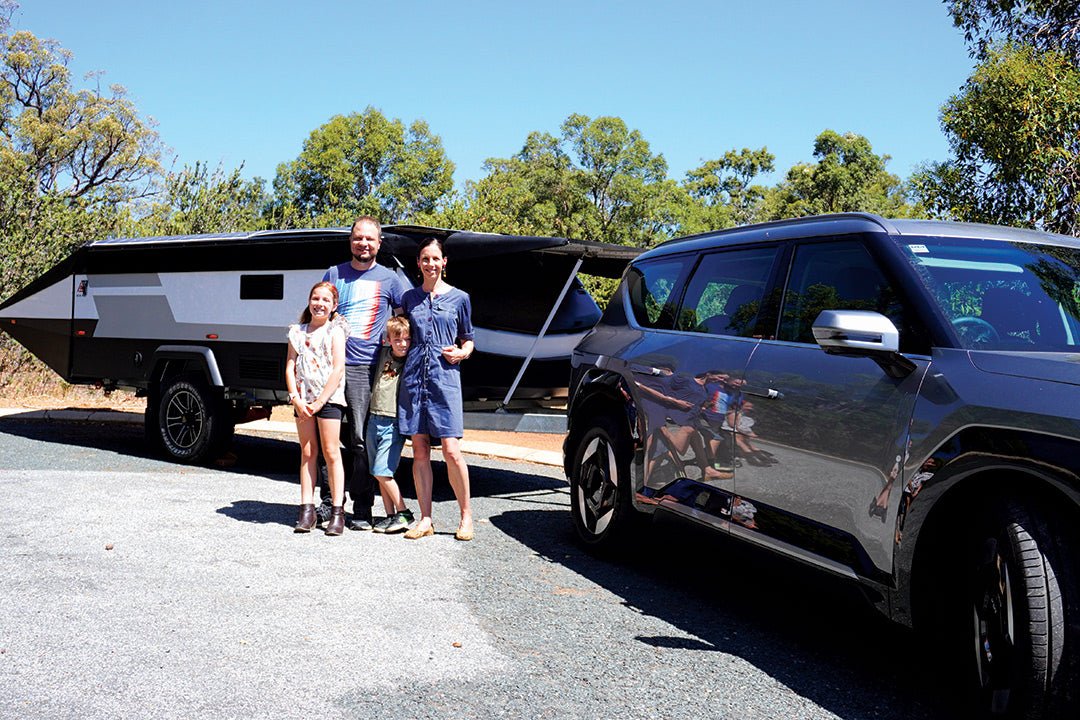
Former Australian Prime Minister, Scott Morrison famously claimed that EVs would “end the weekend”. But Renée and Tim McLennan are out to prove him wrong, towing a camper trailer with an EV and taking their family on an all-electric Big Lap of Australia with their New Age camper and Kia EV.
Our daughter turned 10 this year. A decade gone in the blink of an eye. A reminder that quality time all together is fleeting and enough to encourage us to take the opportunity for a family adventure when it came our way.
When Tim was the same age, his family travelled Australia in a Toyota LandCruiser Troop Carrier towing a Baravan. It was one of the most memorable experiences of his childhood, and he still shares the stories of that expedition. Being able to explore the country and connect with nature, his parents and sister had a permanent impact. It was precious time that helped to shape his lifelong love of adventure and develop his appreciation for nature.
The marvel that is long service leave offered us the chance to recreate a similar experience with our own children. We want them to grow up knowing the wonder of this vast land and being connected to Country. Like all of us who love the great outdoors, we strive to minimise our impact on nature, so the idea of doing our Big Lap all-electric was appealing; not only as an exciting challenge, but also as a way to tread a little more lightly on the planet.
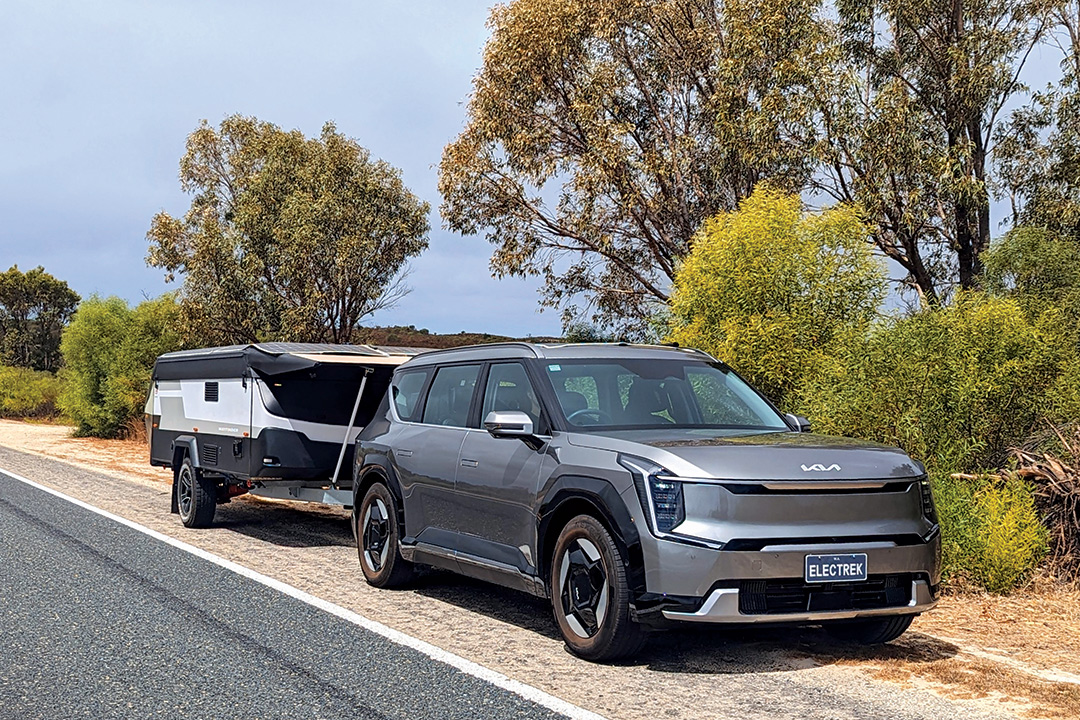
Our family is affectionately known as the T-REX Family based on the acronym from our first names: Tim, Renee, Elliott (10) and Xavier (7). We’ve always been nature lovers, who value Australia’s unique landscapes and wildlife, and therefore do what we can to help preserve it. Becoming parents made us even more acutely aware of the challenges facing our environment and making what choices we can to reduce our impact where possible. One of the things we’ve been able to do is electrify our transport. Over the past decade our family has made the transition from internal combustion engine (ICE) vehicles, to hybrids, to plug-in hybrids and finally to battery electric vehicles. Having gone all electric and experienced the benefits of the technology, the cost savings and the reduction in our carbon footprint we were very reluctant to go back.
For the first time, Australia is starting to open up for electric vehicle travel thanks to more EVs entering the Australian market, rapidly improving battery technology and the roll out of charging infrastructure across that nation. Tim’s knowledge and skills as an electrical engineer have allowed us to take advantage of this window and be early adopters of all-electric travel. We hope our journey will play a small part in helping to progress more sustainable travel in Australia and remove obstacles for others who may also want to choose this option in future.
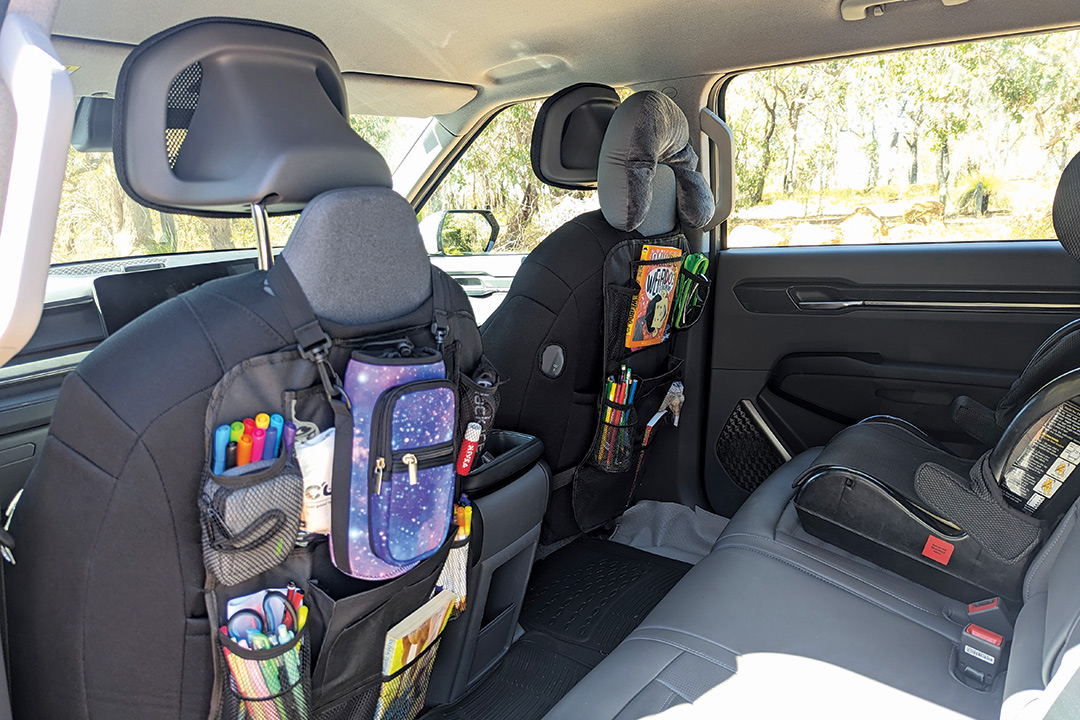
Electric transition
Unfortunately, Australia has lagged behind much of the world with the transition to electrification and charging infrastructure is only now starting to roll out across the country. Our ElecTrek was timed to coincide with the scheduled launch of the new WA Electric Vehicle Highway which, when completed, will be Australia’s longest charging network. EV drivers will have access to fast chargers at approximately 200km intervals across 49 locations, from Eucla at the South Australian border to Kununurra in the far north of Western Australia.
Complementing this, the Federal Government, in partnership with motoring group NRMA, is currently building a EV network of fast-charging stations along key highway routes across Australia at an average interval of 150km, connecting all capital cities and more regional and rural areas of Australia.
There continues to be limited infrastructure in remote parts of Australia and range anxiety is an issue for EV travellers that is continuously raised. An extended electric trip in a vast nation like Australia does require proper planning, but it is worth remembering that every power point is a potential charging station if needed, and there are far more power outlets around the country than there are fuel stations.

The ElecTrek
Our family’s ElecTrek will commence from our home city of Perth, with plans to circumnavigate the country in a clockwise direction. We are travelling with a Kia EV9 Earth as our tow vehicle pulling a fully electric, aerodynamically enhanced New Age Wayfinder Adventurer 12F camper.
We have calculated that the EV and camper combination need to achieve a range of 270km to comfortably bridge the gap between charging stations along our planned route. We have no interest in this trip just being a tour of charging stations, so we have also factored in getting off the highways to visit many of Australia’s iconic destinations.
Tim has undertaken all the aerodynamic modifications to help ensure that this distance is achievable. With a love of gliding and a career in electrical engineering, his understanding of aerodynamics and electrification have been invaluable assets to making this adventure possible.
 Inverter and EV supply equipment (EVSE)
Inverter and EV supply equipment (EVSE)
We have to return to Perth in nine months and intend to use all this time to make our way around the country exploring at a relaxed pace. Despite Australia’s charging infrastructure still being in the early stages of rollout, it is already possible to travel around Australia at a much faster rate for those who wish to do so. The current record was set in 2023, when a full lap was completed in a Tesla in just 10 days. However, our aim is not to beat any speed records, but to slow down and take our time enjoying what Australia has to offer together as a family. If we can do that and have less impact on the earth while doing it, that ticks a lot of boxes for us.
Electric travel
Improvements in battery technology have resulted in vehicles with significantly increased range, with many EVs now capable of driving in excess of 500km (unloaded) on a single charge making EV travel a more viable option.
We were fortunate to acquire the very first Kia EV9 Earth in Western Australia to use as our tow vehicle. The Earth was chosen partially due to its 2.5 tonne tow rating, one of the highest of EVs currently available in Australia. It also offers all-wheel drive (AWD) capability, allowing us to also contemplate offroad travel. Its offroad performance so far has been impressive, limited primarily by clearance, but still a respectable 200mm off the ground.
The Earth is well suited for travelling in comfort. It has a 570L boot capacity in the seven-seater configuration, 1230L in the five-seater configuration and a cavernous 2315L in the two-seater configuration; plus, an additional 50L in the frunk (the front trunk under the bonnet where an ICE would ordinarily be). In the absence of a drive shaft, the internal feet space is superior due to the flat floor architecture. It is similar in dimensions to a LandCruiser and provides generous room for both front and rear passengers.

The Earth possesses a whopping 100kWh battery. Kia advertises it as delivering a 515km (51.5kWh/100km) combined average range and this aligns with our real-world driving experience. The battery can charge from 10–80 per cent in 24 minutes using a DC fast EV charger. Alternatively, 225km can be added with a 15-minute top up, which is perfect for a quick coffee stop after a few hours driving.
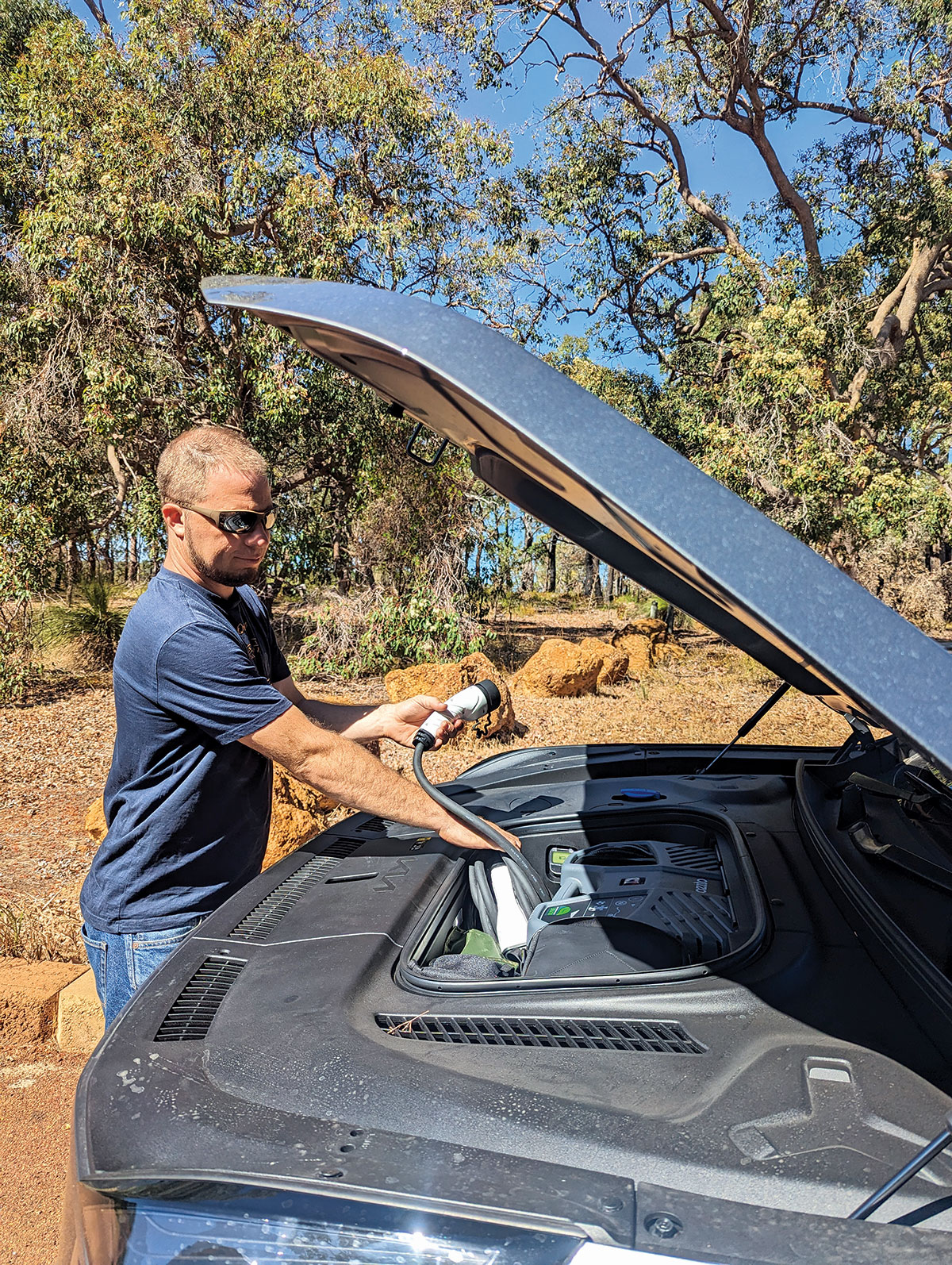
Purchasing the vehicle was a risk as its towing performance was an unknown factor with no data being available and Kia not yet having tow kits available. Fortunately, we were able to obtain a custom towbar from EV Stealth Solutions in time for us to do some tow trials prior to our departure.
The tow testing results have exceeded what we were hoping for with the Earth pulling the 2T camper with ease. It maintains great stability when towing, due partially to the 2.5T mass of the vehicle and low centre of mass of its batteries. The car accelerates almost effortlessly, demonstrating how perfectly suited electric motors are for towing given their ability to generate maximum torque from zero RPM.
Towing at an average speed of 95km/h, into a slight head wind and with the aircon on, has resulted in an energy consumption of 3.3km/kWh (30kWh/100km), achieving in excess of 300km range. More than enough to bridge the gaps between the charging stations on our planned route.
Aerodynamic solar camper
To successfully complete the Big Lap requires maximising the range that the EV can travel between charging stations in remote areas by minimising the drag created by the camper.
To maximise range, we have made aerodynamic modifications to the camper to smooth airflow and reduce drag. The enhancements include a wedge boot, forward and rear roof extensions matching the tow vehicle height, undertray and stretch canvas linking the vehicle to the trailer.
The camper has also undergone full electrification. The extensions maximised the roof area for 2.1kW solar panels (plus an additional 400W on the roof of the EV9) to give a combined 2.5kW of solar capacity.
The camper batteries were upgraded to 10kWh high capacity, relatively low weight, 48V, lithium iron phosphate (LiFePO4) onboard battery. This storage capacity roughly equates to an 830Ah 12V battery. The batteries can be used for both powering the camper and as a backup charger for the EV. In addition, having everything electric means that power can also be drawn from the car battery if needed to run the camper.
All gas appliances were converted to electric including induction cooktops, electric hot water system, and converting the barbecue point to a power outlet. Inefficient appliances were also upgraded to energy efficient electric alternatives. For example, the standard three-way fridge was replaced with an electric compressor version which consumes less than a fifth of the power (compared to the three-way fridge) when running from a 12V source.
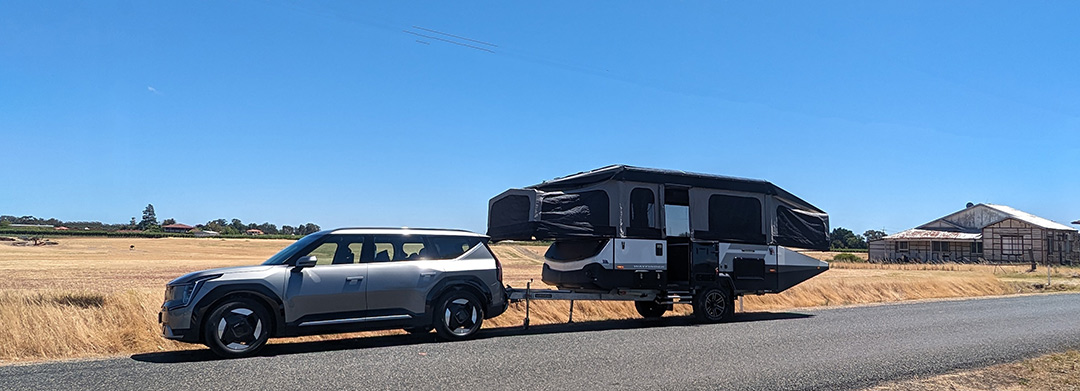
Power sources
Ordinarily, we charge our EV at home from renewable energy from our rooftop solar. However, the public charging locations that we will use across the country have a variety of power sources. Some stations are connected to the grid network, while others are powered by a combination of renewables and battery, with a backup generator.
The ideal is charging the EV from 100 per cent renewable sources. However, even when renewable energy sources are not available the EV is far more efficient than the equivalent ICE vehicle. This efficiency significantly reduces our energy costs as well as the carbon emissions generated over the equivalent distance.
Dedicated charging infrastructure in the most remote parts of the country remains limited. Many communities in these regions continue to rely upon hybrid energy systems combining renewables with diesel generators as their power source. In an instance when an EV may use a diesel generator to charge, the vehicle will still generate zero exhaust emissions and will require less than half the volume of diesel that an ICE would require to travel the equivalent distance.
Locating chargers
Due to the relatively small number of charging stations, ‘refuelling’ with the EV needs to be a little more strategic. Fortunately, there are multiple apps available such as PlugShare, Charge Fox, A Better Route Planner, Evie and Waze to help locate the nearest town or location to power up.
PlugShare is one example of the free, online, open-source tools that provides information about public EV charging stations. It also details charging speeds and plug types, as well as flagging whether a charge is out of action or currently in use. In addition, it also has a useful trip planning function that identifies where various charging stations are located along the chosen route.
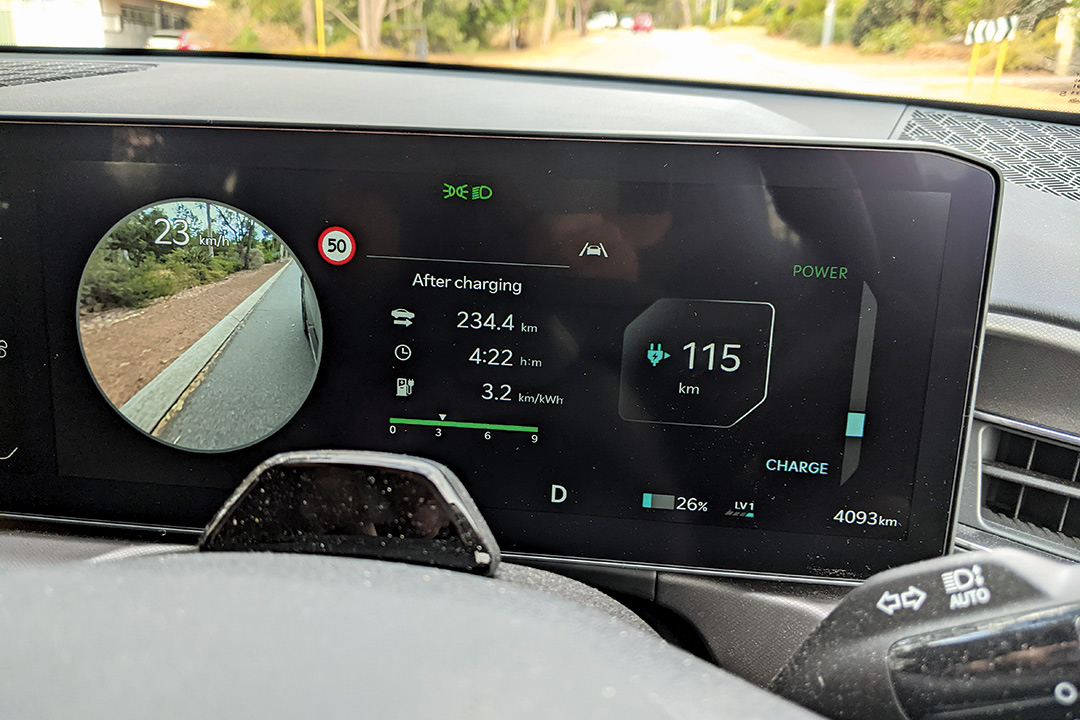
In the absence of a dedicated charger, EVs can be charged off three phase or single-phase standard power points if necessary. Staying overnight at a powered site has the potential to give you over 200km (from a 10A standard socket) or 300km (from a 15A plug) in driving range for the next day.
While writing this article, we are in the final stage of planning and packing up our house with a scheduled departure in late March. We will share our progress and the inevitable challenges in coming editions.
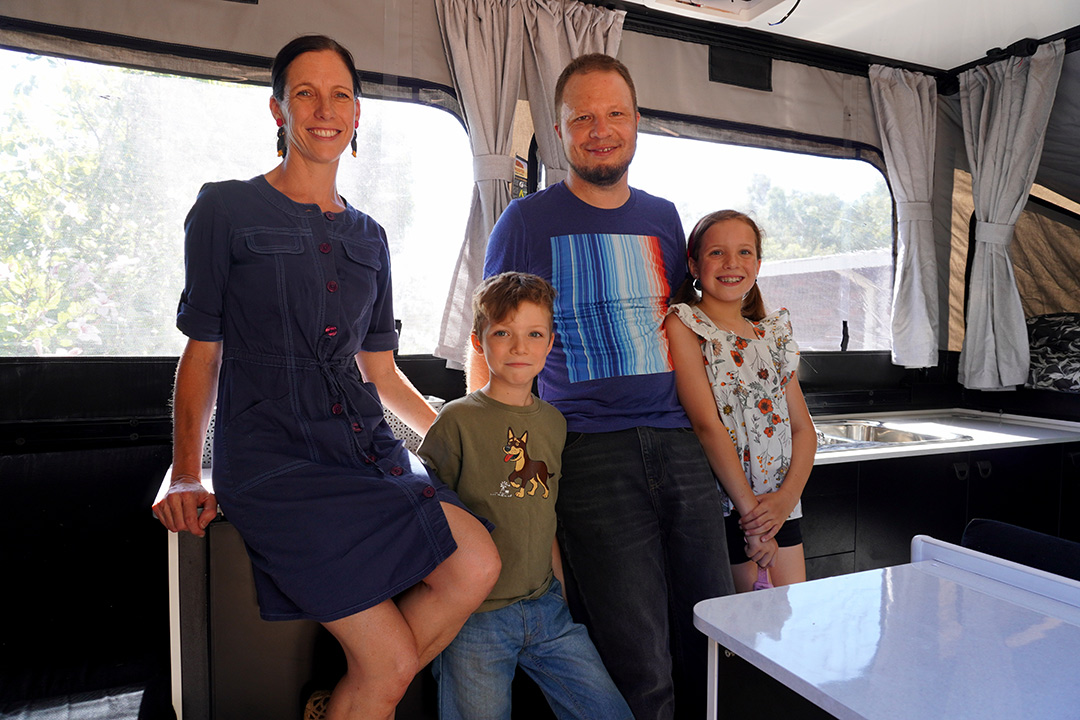
Follow the electric adventure
Website | electrekking.net
Facebook | facebook.com/Electrekking
Instagram | Electrekking
And keep an eye out for further stories from Tim and Renée McLennan and co as they head out on their all-electric nine-month trip.
THE NEXT STEP
Are you ready to experience the freedom of the open road? Don't wait - Find your dream getaway now!







